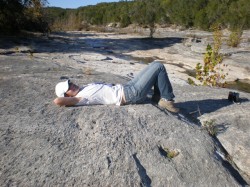Cow Creek Cretaceous Beach Complex: Facies and Depositional History

Leigh Owens
I have had the privilege to conduct my undergraduate research under Dr. Kerans, at one of the best-exposed carbonate fossil beach complexes, the Cow Creek Formation, found in the Phanerozoic sedimentary record. This formation is Aptian (Cretaceous) in age and is located in Travis County near Lago Vista. It has high-energy units that record deposition of a land-attached prograding beach complex in the upper highstand.
During this research, I spent approximately two weeks collecting and measuring vertical sections in five locations from more landward (north) to more seaward (south). Using my sample collections, thin sections were made and analyzed. I was able to identity five facies from the detailed analysis of grain size, sedimentary structures, and major allochems, and using my photomosaics with bedding tracings that span the 300m lateral extent of the Cow Creek outcrop.
This study utilizes the Cow Creek foreshore-upper shoreface exposure to map and document the sedimentary facies. The widths and lateral extents of these facies was used to constrain the likely water-depth range of the receiving basin during the Aptian. A clinothem for the ancient prograding beach complex was constructed using outcrop data. This study details the depositional history of the Cow Creek Formation in the greenhouse climatic conditions of the Lower Cretaceous and establishes a microtidal, wind-dominated, foreshore-shoreface environment.
The Cow Creek beach complex was created over 1 to 2 million years during the “green house” times of the Cretaceous. Detailed measured sections, photomosaic mapping and petrography provided data to constrain the Cow Creek beach model.
A 5-fold facies scheme was developed to characterize the beach model. The facies tract widths for the foreshore, upper shoreface, lower shoreface, and offshore were identified. The tidal range was estimated to be 1 m and the fair weather wave base of the wind-driven system was estimated to be 5m. The combination of the tectonically stable platform and the greenhouse setting control formation of the extensive beach ridge plain.
Using the facies and combining this information with the dimensional data extracted from the detailed photomosaic interpretation, a semiquantitatively constrained model of an Aptian prograding beach complex was provided as a result of this study.